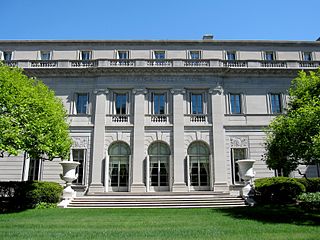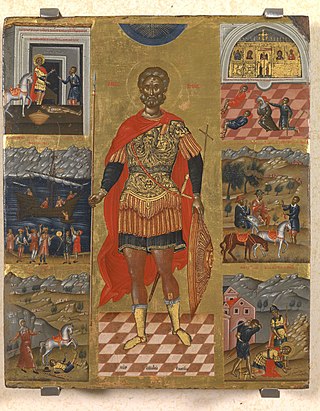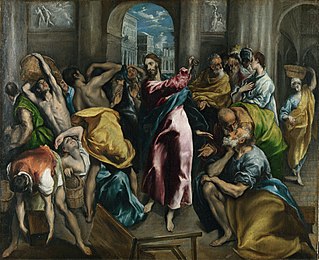
Domḗnikos Theotokópoulos, most widely known as El Greco, was a Greek painter, sculptor and architect of the Spanish Renaissance. El Greco was a nickname, and the artist normally signed his paintings with his full birth name in Greek letters, often adding the word Κρής, which means "Cretan".

Bartolomé Esteban Murillo was a Spanish Baroque painter. Although he is best known for his religious works, Murillo also produced a considerable number of paintings of contemporary women and children. These lively realistic portraits of flower girls, street urchins, and beggars constitute an extensive and appealing record of the everyday life of his times. He also painted two self-portraits, one in the Frick Collection portraying him in his 30s, and one in London's National Gallery portraying him about 20 years later. In 2017–18, the two museums held an exhibition of them.

The Frick Collection is an art museum in New York City. Its permanent collection features Old Master paintings and European fine and decorative arts, including works by Bellini, Fragonard, Goya, Holbein, Rembrandt, Titian, Turner, Velázquez, Vermeer, Thomas Gainsborough, and many others. The museum was founded by the industrialist Henry Clay Frick (1849–1919), and its collection has more than doubled in size since opening to the public in 1935. The Frick also houses the Frick Art Reference Library, a premier art history research center established in 1920 by Helen Clay Frick (1888–1984).

The National Museum of Art of Romania is located in the Royal Palace in Revolution Square, central Bucharest. It features collections of medieval and modern Romanian art, as well as the international collection assembled by the Romanian royal family.

The cleansing of the Temple narrative tells of Jesus expelling the merchants and the money changers from the Temple and is recounted in all four canonical gospels of the New Testament. The scene is a common motif in Christian art.

The Burial of the Count of Orgaz is a 1586 painting by El Greco, a prominent Renaissance painter, sculptor, and architect of Greek origin. Widely considered among his finest works, it illustrates a popular local legend of his time. An exceptionally large painting, it is divided into two sections, heavenly above and terrestrial below, but it gives little impression of duality, since the upper and lower sections are brought together compositionally.

The Disrobing of Christ or El Expolio is a painting by El Greco begun in the summer of 1577 and completed in the spring of 1579 for the High Altar of the sacristy of the Cathedral of Toledo, where it still normally hangs. In late 2013 it was on temporary display at the Prado in Madrid, following a period of cleaning and conservation work there; it was returned to Toledo in 2014. It is one of El Greco's most famous works. A document dated July 2, 1577 which refers to this painting is the earliest record of El Greco's presence in Spain. The commission for the painting was secured thanks to El Greco's friendship from Rome with Luis, the son of Diego de Castilla, the dean of the Cathedral of Toledo. De Castilla senior also arranged El Greco's other major commission, on which he worked simultaneously, the paintings for the Toledan church of Santo Domingo el Antiguo.

Cretan School describes an important school of icon painting, under the umbrella of post-Byzantine art, which flourished while Crete was under Venetian rule during the late Middle Ages, reaching its climax after the Fall of Constantinople, becoming the central force in Greek painting during the 15th, 16th and 17th centuries. The Cretan artists developed a particular style of painting under the influence of both Eastern and Western artistic traditions and movements; the most famous product of the school, El Greco, was the most successful of the many artists who tried to build a career in Western Europe, and also the one who left the Byzantine style farthest behind him in his later career.

The Maestà, or Maestà of Duccio is an altarpiece composed of many individual paintings commissioned by the city of Siena in 1308 from the artist Duccio di Buoninsegna and is his most famous work. The front panels make up a large enthroned Madonna and Child with saints and angels, and a predella of the Childhood of Christ with prophets. The reverse has the rest of a combined cycle of the Life of the Virgin and the Life of Christ in a total of forty-three small scenes; several panels are now dispersed or lost. The base of the panel has an inscription that reads : "Holy Mother of God, be thou the cause of peace for Siena and life to Duccio because he painted thee thus." Though it took a generation for its effect to be truly felt, Duccio's Maestà set Italian painting on a course leading away from the hieratic representations of Byzantine art towards more direct presentations of reality.

Christ Carrying the Cross on his way to his crucifixion is an episode included in the Gospel of John, and a very common subject in art, especially in the fourteen Stations of the Cross, sets of which are now found in almost all Roman Catholic churches, as well as in many Lutheran churches and Anglican churches. However, the subject occurs in many other contexts, including single works and cycles of the Life of Christ or the Passion of Christ. Alternative names include the Procession to Calvary, Road to Calvary and Way to Calvary, Calvary or Golgotha being the site of the crucifixion outside Jerusalem. The actual route taken is defined by tradition as the Via Dolorosa in Jerusalem, although the specific path of this route has varied over the centuries and continues to be the subject of debate.

Christ Driving the Money Changers from the Temple is a 1600 painting by El Greco, now in the National Gallery in London, England. It depicts the Cleansing of the Temple, an event in the Life of Christ.

Christ Driving the Money Changers from the Temple is a 1609 Christian art painting by El Greco, now in the church of San Ginés in Madrid. It depicts the Cleansing of the Temple, an event in the Life of Christ.

Christ Driving the Money Changers from the Temple is a painting by El Greco, from 1568, now in the National Gallery of Art in Washington, D.C., in the United States. It depicts the Cleansing of the Temple, an event in the Life of Christ.

Christ Driving the Money Changers from the Temple is a 1571 Christian art painting by El Greco, now in the Minneapolis Institute of Art. It depicts the Cleansing of the Temple, an event in the Life of Christ.

Saint Luke is a painting by an artist known as El Greco. The painting is an oil on canvas created sometime around 1610-1614. It is currently held by the Indianapolis Museum of Art in Indianapolis, Indiana.

The El Greco Museum is located in Toledo, Spain. It celebrates the mannerist painter El Greco, who spent much of his life in Toledo, having been born in Fodele, Crete.

Christ Carrying the Cross is an oil painting by El Greco, produced early in his Toledo period circa de 1580. The picture depicts Christ in a moment of personal reflection as he carries the cross to his death, therefore committing the ultimate sacrifice for humankind. In the painting, Christ's eyes are lifted up to the heavens as he begins his walk towards his crucifixion. His gentle hands wrap around the cross as a stormy night floods the background. Christ Carrying the Cross is an oil painting, 105x79cm. The painting, one of numerous similar paintings by El Greco, is currently in the El Greco room in the New York art collection of the Metropolitan Museum of Art.
Rudolph J. Heinemann, also known as Rudolf J. Heinemann, was a German-born American art dealer and collector of Old Masters. He was an advisor to Baron Hans Heinrich Thyssen-Bornemisza, who established a museum in Lugano, Switzerland with his help. Heinemann and later, his wife Lore, donated works of art to the Metropolitan Museum of Art, the Frick Collection, the National Gallery of Art and the Morgan Library & Museum.

The Flagellation of Christ is a panel painting by 13th-century Italian artist Cimabue, in egg tempera and gold leaf on a poplar panel, dated to c.1280. It has been held by the Frick Collection in New York since 1950, and is the only painting by Cimabue in the US. The Frick Collection acquired the painting from the Knoedler gallery in Paris in 1950. Previously, it had been owned by the antiques dealer M Rolla at the end of the 19th century, inherited by G Rolla, and then sold to the art dealer Eduardo Moratilla.

















